Menus
- mixed double
- How much superbike is there left in the naked bikes??
- Aprilia RSV4 RF and Aprilia Tuono V4 1100 Factory
- RSV4 1.3 kilos lighter than the Tuono
- The Tuono is faster from 30 to 100 km / h
- Anyone looking for a flawless race feeling needs the RSV4
- Main differences between RSV4 RF and Tuono
- BMW S 1000 R and BMW S 1000 RR
- The rider has to work more on the S 1000 RR
- BMW S 1000 R has an ace up its sleeve
- Main differences between S 1000 RR and S 1000 R
- Yamaha YZF-R1 and Yamaha MT-10
- MT-10 makes the R1 work up a sweat
- The price difference between R1 and MT-10 is tough
- Main differences between R1 and MT-10
- This is how the bikes did on the handling course
- MOTORCYCLE conclusion
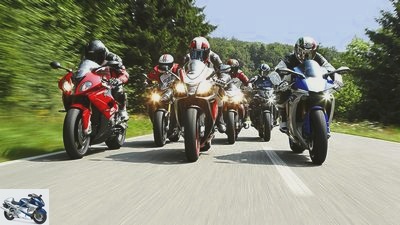
www.factstudio.de


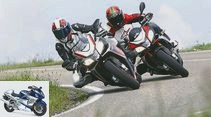
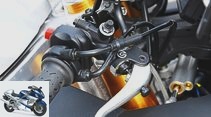
39 photos
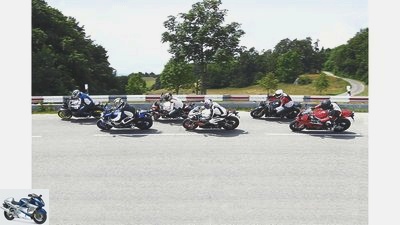
factstudio.de
1/39
The big concept comparison: three super athletes compete against their naked bike derivatives.
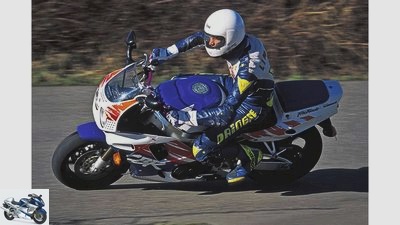
2/39
Superbike conversions in 1995: The trend of screwing tall handlebars onto superbikes reached its peak in the mid-1990s. The conversion seldom did the driving behavior any good.
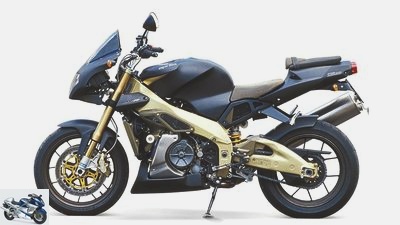
Rossen Gargolov
3/39
Aprilia RSV mille Tuono 2003: Deriving directly from the superbike, the Tuono is the first series-produced power-naked bike. The Italian influences the concept of the hypersportful nude to this day.
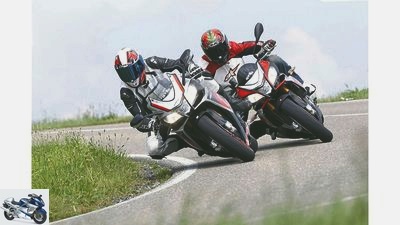
factstudio.de
4/39
Aprilia: RSV4 RF versus Tuono 1100 Factory.
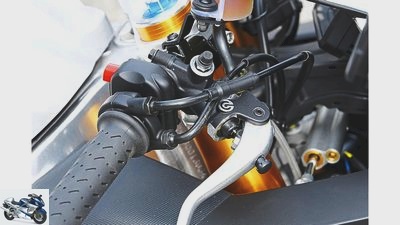
factstudio.de
5/39
RSV4: Radial brake pump for constant and crisp pressure point, fork protrusion three rings.
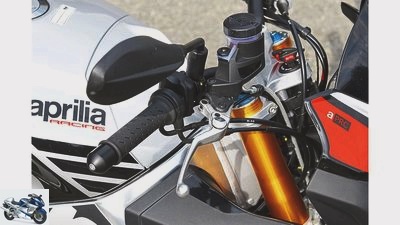
factstudio.de
6/39
Tuono: The conventional brake pump of the Tuono works with significantly more free travel on the lever, fork protrusion four rings.
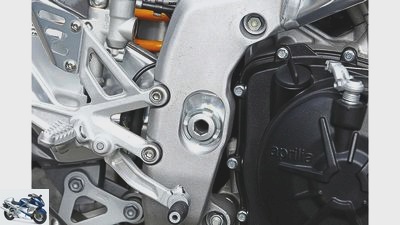
factstudio.de
7/39
RSV4: High-end delicacies for racers: In addition to the steering head and motor position, the position of the pivot point is also variable.
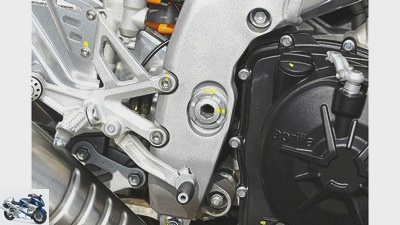
factstudio.de
8/39
Tuono: A variable swing arm pivot point, which is expensive to manufacture, makes little sense for road drivers.
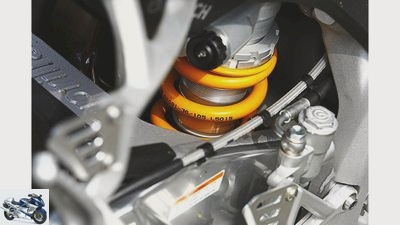
factstudio.de
9/39
RSV4: Spring with 105 N / mm spring rate for full stability. With the taut seat pad, there is hardly any room for comfort.
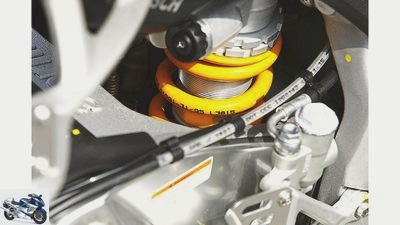
factstudio.de
10/39
Tuono: Good to see, softer nib with a spring rate of 95 N / mm. Good compromise between comfort and good roadholding.
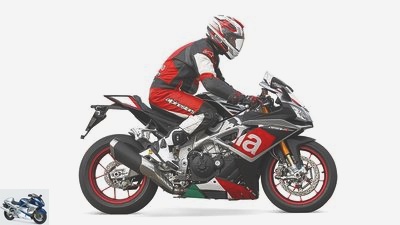
bilski-fotografie.de
11/39
The sitting posture of the V4 Tuono is clearly sporty.
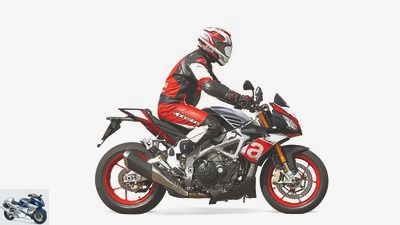
bilski-fotografie.de
12/39
This also means that the weight distribution of the Tuono with the driver differs slightly. 47, instead of 48 percent on the front wheel.

bilski-fotografie.de
13/39
The bottom line is that the Tuono perfectly conveys the sporty attitude of the RSV4 with its powerful sound and brilliant handling. In addition, an engine like a seething volcano, enriched with a good portion of suspension comfort. If that’s not sharp enough, if you’re looking for a flawless race feeling, the RSV4 is recommended.

MOTORCYCLE
14/39
Performance measurements of the two Aprilias.
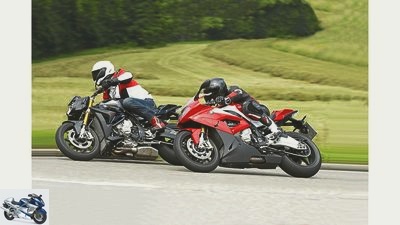
factstudio.de
15/39
BMW: S 1000 RR against S 1000 R..
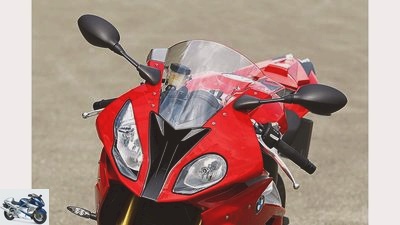
factstudio.de
16/39
S 1000 RR: The athlete’s stub: 670 millimeters narrow, also cranked back and down by more than 20 degrees.
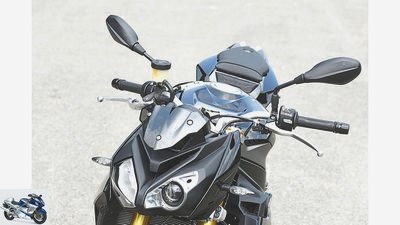
factstudio.de
17/39
S 1000 R: The naked handlebar is 740 millimeters wide and offers a good lever arm.
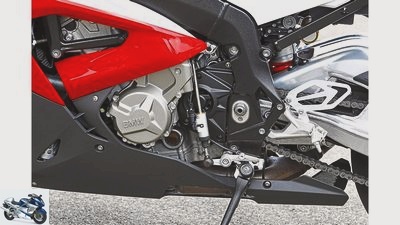
factstudio.de
18/39
S 1000 RR: The height of the swing arm can be changed using an inlay. Clearly visible: the modified frame in the footrest area.
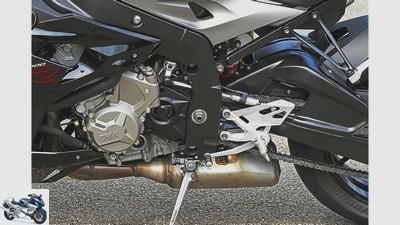
factstudio.de
19/39
S 1000 R: The pivot point is fixed and is significantly lower than that of the super sports car from the same company.
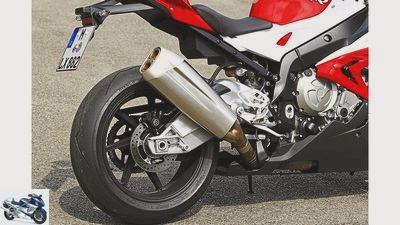
factstudio.de
20/39
S 1000 RR: The athlete has the larger damper, but there is no “bread box” under the engine. Saves three kilos in weight.

factstudio.de
21/39
S 1000 R: A short pot, but a large-volume front silencer – this is what the exhaust layout of the S 1000 R looks like.
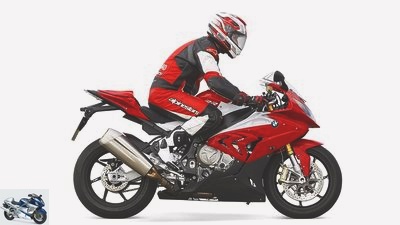
bilski-fotografie.de
22/39
Objectively, the S 1000 RR has a three percent heavier front.
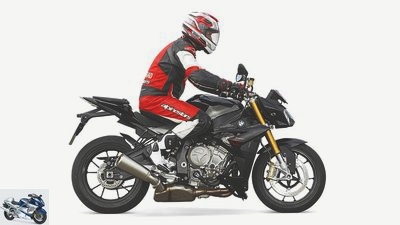
bilski-fotografie.de
23/39
Subjectively, the S 1000 R has perfect feedback.
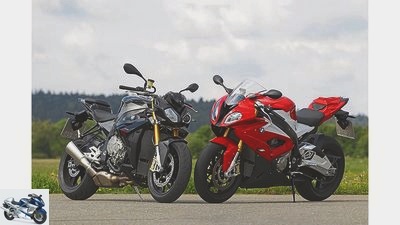
bilski-fotografie.de
24/39
The full torque of the bare down below can be used more easily and effectively over land or here on the course. If the radii get bigger, the speed higher, things would look different quickly. But that would be a different story – then on the racetrack.
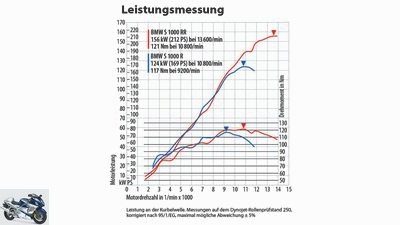
MOTORCYCLE
25/39
Performance measurements of the two BMWs.

factstudio.de
26/39
Yamaha: YZF-R1 versus MT-10.
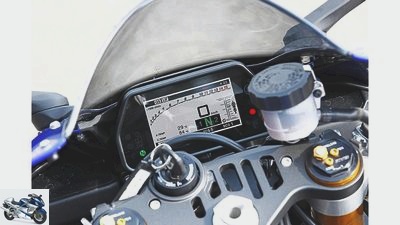
factstudio.de
27/39
YZF-R1: Nice thing: everything you want to know. In color and razor-sharp – on the R1’s TFT display.

factstudio.de
28/39
MT-10 One thing is clear: only black and white, but clear and informative – the MT-10’s monochrome display.
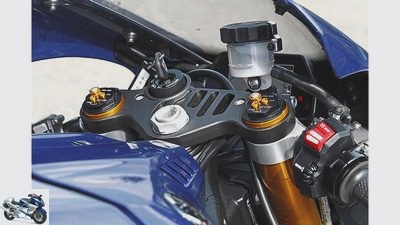
factstudio.de
29/39
YZF-R1: Down: The stubs on the R1 sit far in front and are narrow. That puts pressure on the front.
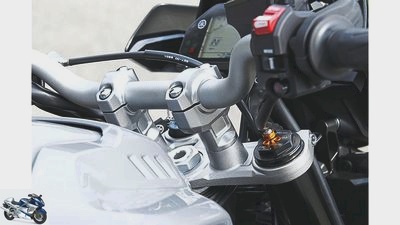
factstudio.de
30/39
MT-10: Top: The handlebars are not mounted higher on any of the trio’s naked bikes than on the MT-10. That brings comfort.
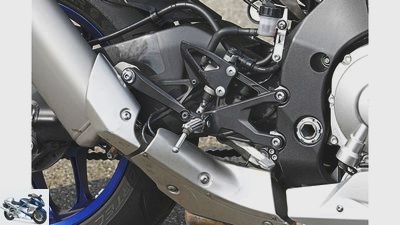
factstudio.de
31/39
Up: The notches on the R1 are a stately 50 millimeters closer to the seat than on the MT-10.
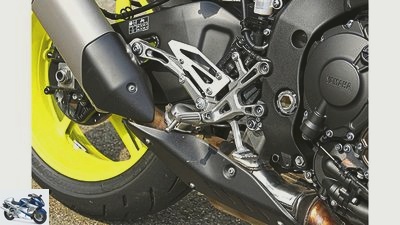
factstudio.de
32/39
Down: The lowered footrest mounts ensure the most open knee angle in the test field.

bilski-fotografie.de
33/39
Big differences in ergonomics …
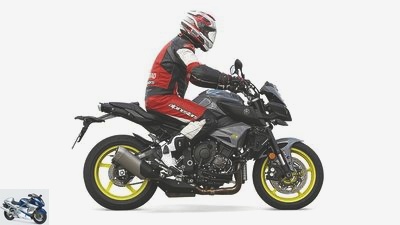
bilski-fotografie.de
34/39
– the Yamaha duo.
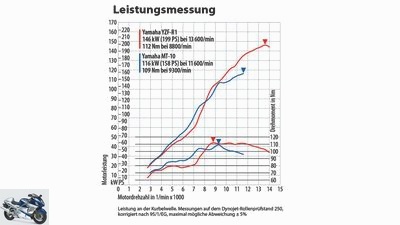
MOTORCYCLE
35/39
Yamaha’s performance measurements.
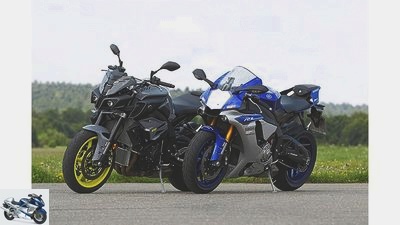
bilski-fotografie.de
36/39
Thanks to the wide handlebars and relaxed ergonomics, the MT-10 trainer not only balances the naked woman more quickly through the pylon forest under the laboratory conditions of the MOTORCYCLE handling course, but also through the thicket of curves on the house route more effortlessly and, above all, with a much better overview of the game. Ultimately, the R1 could only play its aces on the racetrack.
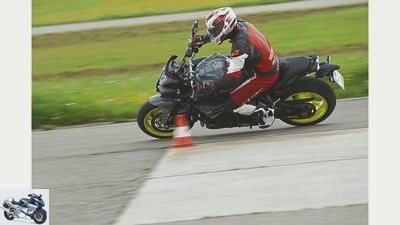
bilski-fotografie.de
37/39
Wide handlebars, good overview: That makes you fast in tight corners.
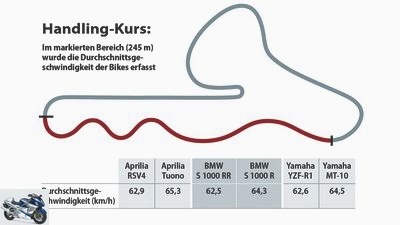
MOTORCYCLE
38/39
The handling course.

factstudio.de
39/39
All motorcycles in this comparison test combined in one picture.
Concept comparison of super athletes and naked bikes from BMW, Yamaha and Aprilia
mixed double
It depends what you make of it – the concrete industry once proclaimed. A slogan that also applies to superbikes and their naked bike derivatives. A look at three mixed duos from BMW, Yamaha and Aprilia with the same genes.
S.the Americans were to blame. In the early 1980s, the AMA Superbike championship had reached its zenith. Future GP stars like Eddie Lawson, Wayne Rainey or Freddie Spencer persevered mercilessly in the US series. The images of the heroes who fought for every millimeter behind the wide and raised handlebars of the Kawasaki Z 1000 or Honda Bol d’Or went around the world. And with them the ideal image of an American superbike – visually significantly characterized by the protruding steering antlers. The fact that superbikes in Europe refer to racing machines with full fairing is ignored by the language of the motorcycle scene to this day.
Buy complete article

Concept comparison of super athletes and naked bikes from BMW, Yamaha and Aprilia
mixed double
Naked bikes have overtaken super athletes
Difficulties that Aprilia RSV mille Tuono also had to contend with. Nevertheless: The Italian presented in 2003 is considered to be the pioneer of the undisguised power naked bikes, which are technically directly derived from the sporty sister models. In the meantime, the bare muskets have long outstripped their family sports friends, and invariably sell better than their superbike counterparts. Some manufacturers even do without internal idea and organ donors entirely.
The Ducati Monster family, the KTM 1290 Super Duke R or the Triumph Speed Triple, for example, established themselves technically alone and are therefore more street fighters than power nakeds despite similar technical key data. But whether with or without a superbike rifle help, the recipe for success remains unchanged: high-tech and tremendous power in a cover suitable for everyday use. Conceptually geared towards high-emotion use on country roads.
How much superbike is there left in the naked bikes??
The technical adjustments also paved the way to success for the Kraft-Nackedeis. Narrower inlet ducts, larger flywheels and reduced peak performance domesticate the engines. A flatter steering angle, longer caster or a sitting position that has been moved further forward calm the chassis. Each manufacturer mixes these elements in different doses – and thus deliberately separates the dissimilar sisters more or less far from one another.
The three most highly developed duos of Aprilia, BMW and Yamaha in this segment serve as an example to determine the position. They answer the question: How much superbike is there still in the Aprilia V4 1000 Tuono Factory, BMW S 1000 R and Yamaha MT-10? And so much in advance: It is astonishing how much the genetically similar couples ultimately transform into completely different characters through the changes. But one aspect unites the dissimilar sisters: They are among the technically and driver-wise most attractive designs in motorcycle construction..
Aprilia RSV4 RF and Aprilia Tuono V4 1100 Factory
If you only glance at the Aprilia V4 1000 Tuono Factory and the Aprilia RSV4 RF, you could mistake both for twins. Stop, of course, the Tuono’s wide handlebars, when you take a second look, you’ll notice it. As well as the lack of full fairing. But otherwise both look confusingly similar. Does that also apply to the performance of the two?
Is the Aprilia V4 1000 Tuono Factory just as ruthless as the superbike on the road? Maybe with a touch of comfort on top? The Aprilia RSV4 RF was at the bottom of the specification sheet. With his knees neatly folded, his hands low on the handlebars, the pilot crouches close to the handlebars. In addition, a bone-hard seat cushion that rises slightly towards the back. Not particularly fluffy, but good for the popometer, as racers love.
RSV4 1.3 kilos lighter than the Tuono
The Aprilia V4 1000 Tuono Factory makes no secret of the fact that it is dedicated to the sport. Despite the lower notches, the knee angle is still sporty and the flat handlebar bends the upper body forward. The relationship to the superbike is clearly noticeable. In terms of seat height alone, it is more accommodating – despite the same measured values. Not only because it compresses a little further when you sit down. Your cushion is softer, so it gives more and doesn’t rise backwards. The difference that feels striking, although both seat cushions look spotless at first glance. At the start there is again a tie. The two V4s burst loudly into life. But the first few kilometers over winding country lanes quickly reveal that the differences are at least as great as the similarities.
Especially with the engine. Because while the RSV draws 999 cm³ of 201 hp from racing regulations-compliant 999 cm³, the Aprilia V4 1000 Tuono Factory allows itself three millimeters more drilling, which helps it to almost 1100 cm³. From this, it still generates a hefty 175 hp and, above all, a significantly fuller torque curve. In conjunction with the shorter secondary gear ratio (42 chainring, RSV: 41 teeth), it comes out noticeably more energetic at the exit of the curve, always looking more powerful and livelier. Even without the variable velocity stacks of the RSV4. However, it rotates around 300 rpm higher than the Aprila RSV4 RF even at the same speed. Despite the increase in displacement, the Tuono V4 can also turn as if the devil was after it. He roars angrily towards his top speed at 12,300 rpm. A piece of cake for the RSV4, it creates an incredible 14,500 rpm. Which is why she also got titanium valves. The RSV4 is also reserved for the stiffer and 1.3 kilos lighter engine housing with a deeper oil pan.
The Tuono is faster from 30 to 100 km / h
The fireworks that the Aprilia RSV4 RF burns off at high speeds is awesome. When the performance curve of the Aprilia V4 1000 Tuono Factory slowly flattens out at 10,000 rpm, the RSV4 only really ignites the afterburner and goes off like a cannonball. Unfortunately, this cannot be exhausted very often in everyday life. The characteristics of the Tuono unit can be better implemented there. The torque in third gear speaks volumes. From 30 to 100 km / h, the naked woman decreases 1.4 seconds. It helps in everyday life to keep up, just to shift down a gear. When it comes to the equipment, Aprilia did nothing and donated the Tuono the same ingenious driving aids as the RSV4, including launch control, wheelie control and eight-stage traction control that can be adjusted from the handlebars.
All she has to do is do without goodies such as variable swing arm, motor and steering head position. Things that are unnecessary for highway drivers anyway. It is more important that the Aprilia V4 1000 Tuono Factory does not have to compromise when it comes to the chassis and that it is also equipped with Ohlins spring elements. They are more gentle with softer springs and softer damping. The naked bike nonchalantly irons negligence on the asphalt and still provides impeccable feedback and stability. But the benchmark is clearly set by the superbike. More tightly tuned, the Aprilia RSV4 RF turns razor-sharp thanks to lighter forged wheels, steeper steering angles, less caster and weight. It moves its course with astonishing precision and is more open to course corrections in an inclined position. However, the Tuono makes it easier to change lean angles in quick succession. Instead of leaning heavily on deep handlebar stubs, the Tuono driver jerks his V4 on the wide handlebars through successive alternating curves. This is also evident on the test course, which the Tuono masters at a higher speed than the race bike.
Anyone looking for a flawless race feeling needs the RSV4
But it is important to reduce the speed again, the Aprilia V4 1000 Tuono Factory is left behind. The brake system, composed of a conventional brake pump and two-part radial calipers, does not come close to the cream stoppers of the Aprilia RSV4 RF in terms of pressure point and controllability. Equipped with a radial pump and one-piece M-50 pliers, they grip more spontaneously, with more bite and a stable pressure point.
The bottom line is that the Aprilia V4 1000 Tuono Factory perfectly conveys the sporty attitude of the RSV4 with its powerful sound and brilliant handling. In addition, an engine like a seething volcano, enriched with a good portion of suspension comfort. If that’s not sharp enough, if you’re looking for a flawless race feeling, the Aprilia RSV4 RF is recommended.
Main differences between RSV4 RF and Tuono
| Aprilia RSV4 RF | Aprilia V4 1000 Tuono Factory | |
| engine | ||
| Top performance | 201 hp at 13,000 rpm | 175 hp at 11,000 rpm |
| Torque | 115 Nm at 10,500 rpm | 121 Nm at 9000 rpm |
| Displacement | 999 cm³ | 1077 cc |
| compression | 13.6: 1 | 13; 0: 1 |
| Inlet valve diameter | 33 mm | 32 mm |
| Material valves | titanium | stole |
| Inlet ducts | milled | poured |
| transmission | – | Gears translated three to six longer |
| Secondary translation | Sprocket: 41 teeth | Sprocket: 42 teeth |
| Suction funnel | variable | fix |
| landing gear | ||
| Hand brake pump | radial | conventional |
| Front brake calipers | one-piece, milled | two-part, cast |
| Arm pivot point and motor position | variable | fix |
| Spring rate rear | 105 N / mm | 95 N / mm |
| bikes | forged | poured |
| miscellaneous | ||
| Weight* | 207 kg | 214 kg |
| Acceleration 0-100 km / h | 3.2 sec | 3.32 sec |
| Acceleration 0-200 km / h | 7.4 sec | 8.3 sec |
| Thrust 3rd gear 30-100 km / h | 5.5 sec | 4.1 sec |
| Top speed | 305 km / h | 280 km / h |
| Price test vehicle | 21,590 euros | 18,090 |
* MOTORCYCLE measurements
BMW S 1000 R and BMW S 1000 RR
In 2009, the superbike world held its breath for a moment. With the S 1000 RR, BMW sent its first thoroughbred athlete to the start. Based on the power bike, the naked bike derivative S 1000 R followed in 2013. And like its sporty sister, it quickly became the ruler in its own segment. With the systems, this is hardly surprising, as the two models are quite similar in their basic features. Of course, the naked cannon could not be used without changes. Simply screwing on a wide handlebar was not a solution, because despite the power that had shrunk from 199 to 161 hp, the S 1000 R would hardly have been manageable. She would have a constant tendency towards wheelies or stoppies. More stability was needed. In relation to the first BMW S 1000 RR, for example, the BMW technicians pushed the rear wheel axle further towards the end of the swing arm by lengthening the chain. A change that the current super sports car has now also received from BMW. In addition, the 740 millimeter wide handlebars are relatively low for a naked bike with a height of one meter. The aim of this design is to balance as much load as possible on the front wheel. This is implemented even more consistently with the athlete: The clip-ons are 860 millimeters high, 14 centimeters lower than on the BMW S 1000 R..
The BMW S 1000 R also goes its own way with the angle of attack of the swing arm, which is the same length in both models, as well as the steering head angle. The swing arm is fixed in the frame at a height of 396 millimeters, the double-R is 418 millimeters. Depending on requirements, the mount can still be adjusted downwards in the context of the super sports car. The higher swing arm bearing also requires a different angle of attack for the rear wheel guide. This is 7.3 degrees for the nude and 9.1 degrees for the super athlete. The flatter angle brings stability advantages, which the S 1000 R needs because of its rear-heavy weight distribution. The steering head angle of the R, which is slightly flatter at 65.2 degrees, aims in the same direction. The double-R has a value of 66.5 degrees. In addition, the spring rate is harder at the rear. Due to the different ratios of positive to negative spring travel (S 1000 R: front 70/50 mm, rear 80/40 mm; BMW S 1000 RR: front 75/45 mm, rear 84/36 mm), it has the same length The spring deflection of the semi-active chassis available in both of the two is also slightly higher.
The rider has to work more on the S 1000 RR
The bottom line is that the BMW S 1000 RR has more extreme values that can be used for agile handling due to its front-heavy weight distribution without any loss of stability. The more moderate data of the BMW S 1000 R document: Here the aspect of driving stability has top priority. But all theory is gray. What effect do the different chassis layouts really have, what influence does ergonomics have on fast curve dancing? On the timed part of the MOTORRAD handling course, it counts. From the apex of a generously dimensioned left-hand bend, it goes straight into a left-right loop. At the beginning it has narrow arcs, while the two back radii continue to fall out. The sketch on page 25 shows exactly what it looks like. Ex-IDM racer and MOTORRAD editor Andi Bildl has brought the S 1000 R tires up to temperature. With verve he takes the first bow and wags quickly through the test track.
A little later the helmet is down again, the pilot smiles. A first conclusion: It was quick, casual and relaxed at the same time. Guided by the wide handlebars, the BMW S 1000 R could be steered lightly. Fast can be that simple. Now it’s the turn of the double r. A chassis aimed more towards maneuverability, harder-tuned suspension elements and significantly more power mean that good things can be expected. The RR flies through the first arc, but just by watching it becomes clear: Andi has to work harder to get the BMW S 1000 RR on course by hanging-off. The perceived lightness of the naked woman is gone. This is also demonstrated by the average speed in the tight handling section: the S 1000 R reaches 64.3 km / h, the sporty sister reaches 62.5 km / h. This is not an isolated case when comparing the athletes with the naked bikes. The two kilometers per hour difference between the two BMWs is not much, but in relation to the distance traveled of 245 meters, it is quite a lot. The average speed of just over 60 km / h achieved with the quick succession of left and right turns corresponds roughly to the average speed that also comes out of the joyful country road twist.
BMW S 1000 R has an ace up its sleeve
One thing remains to be said: The super sports car BMW S 1000 RR has a hard time showing off the tighter suspension, the more extreme geometry and the superior performance on the test track. There are several reasons for this. It is much more strenuous to drive around a tight corner in a stooped position; sitting upright is easier. Due to the stumps of the S 1000 RR, which are cranked sharply backwards and downwards, the wide handlebars of the bare BMW S 1000 R have a larger lever arm to initiate steering impulses. Therefore, the apparent advantages of the athlete can hardly be used on the course as on the country road. Also, because in the speed range reached here, the fork and damper of the naked bike work at a very high level, the reserves that the superbike’s chassis offers are not decisive.
And then the BMW S 1000 R has an ace up its sleeve. Your engine is tuned to a lot of smoke in the lower to medium speed range. This is clearly shown by the torque values in third gear from 30 to 100 km / h. This is made possible by an engine configuration with modified intake and exhaust ports, different timing and steeper cam profiles. The result: a higher cylinder charge up to medium speeds. The BMW S 1000 RR also gets down to business, but only unpacks the big power hammer at high revs. This is where performance monitoring becomes trickier. The full torque of the bare down below can be used more easily and effectively over land or here on the course. If the radii get bigger, the speed higher, things would look different quickly. But that would be a different story – then on the racetrack.
Main differences between S 1000 RR and S 1000 R
| BMW S 1000 RR | BMW S 1000 R. | |
| engine | ||
| Top performance | 199 hp at 13,500 rpm | 161 hp at 11,000 rpm |
| Torque | 113 Nm at 10,500 rpm | 112 Nm at 9250 rpm |
| compression | 13.0: 1 | 12.0: 1 |
| Material valves | titanium | stole |
| Suction funnel | variable | fix |
| Weight exhaust system | about 9 kg | about 12 kg |
| landing gear | ||
| Weight frame | 10.8 kg | 11.4 kg |
| Arm pivot height | 418 mm (adjustable) | 396 mm |
| Angle of attack swing arm | 9.1 degrees | 7.3 degrees |
| Steering head angle | 66.5 degrees | 65.2 degrees |
| Spring rate rear | 85 N / mm | 71 N / mm |
| miscellaneous | ||
| Weight | 199 kg | 213 kg |
| Acceleration 0-100 km / h * | 3.2 sec | 3.3 sec |
| Acceleration 0-200 km / h * | 7.1 sec | 8.1 sec |
| Thrust 3rd gear 30-100 km / h * | 4.4 sec | 3.8 sec |
| Top speed | 299 km / h | 258 km / h |
| Price test vehicle | 20,325 euros¹ | 15,105² |
* MOTORCYCLE measurements; ¹incl. Race package (510 euros), dynamic package (1190 euros), HP forged wheels (1225 euros); ²incl. Sports package (805 euros), dynamic package (950 euros)
Yamaha YZF-R1 and Yamaha MT-10
The Yamaha MT-10 leaves no doubt about its emancipation right from the first seat test. 40 percent of the engine parts and 60 percent of the chassis components differ from those of the Yamaha YZF-R1, proclaim the Yamaha engineers. Together they make 100 percent, you could combine them. And would – at least felt – also prove to be right. Because ergonomically, the Yamaha duo differs like spike-soled sprint shoes from trekking sandals. Admittedly, this is not surprising. After all, the engineers let the R1 sniff the tracks of Valentino Rossi’s MotoGP machine as consistently as a keen dog.
No other super sports car in this test field stretches the pilot flatter over the tank, and with the narrowest handlebar in the range (650 mm), none folds it more aerodynamically behind the fairing than the Yamaha YZF-R1. The Yamaha MT-10 is just as extreme. Just at the other end of the ergonomic scale. No bike in this sextet swings the handlebars higher, and none allows a more open knee angle than the naked Yamaha. And none of it is further removed from its super sports origins than the MT-10. No one suspects that the power naked bike could have anything to do with the hypersporting relatives even remotely.
MT-10 makes the R1 work up a sweat
At least as long as the starter button has not been pressed. But then it only takes a moment to realize: This duo has the same heart beating. Crossplane is the name of the layout with which Yamaha transforms the silky smooth purring inline four-cylinder into an adventurer. The quadruplet, which ignites irregularly by 90 degrees due to the crank pin offset, babbles to itself with a bass sound. It has 200 hp in the R1, 160 hp in the MT-10. But fuller cam profiles, more moderate control times, narrower inlet cross-sections keep the gases going, especially at lower and medium engine speeds, and allow the MT-10 engine to gain tangible and measurable strength in the practical range between 5000 rpm and 8000 rpm (see performance diagram). The domesticated MT-10 drive pushes up to ten Newton meters more torque onto the asphalt in this area.
And because a more voluminous airbox, less compression and two kilograms more flywheel mass make the quadruple of the Yamaha MT-10 act even more smoothly, the R1 driver – at least on the country road – has a hard time with the naked sister. The MT-10 rider will not miss one of the 40 sacrificed horses for a moment and will – also due to the shorter final transmission (sprocket with 43 instead of 41 teeth) – make the buddy on the R1 sweat. He takes three quarters of a second from him while sprinting in third gear typical for the country road from 30 to 100 km / h. Because the Yamaha YZF-R1 suffers from its shortness of breath below 7000 rpm, especially on winding terrain, and – to put it casually – does not get out of the quark after tight turns.
The price difference between R1 and MT-10 is tough
But she would have the capacity to steal the show from the stripped. Because the Yamaha MT-10 may put as much load on the front wheel statically as the other naked bikes, but the situation changes while driving. There, the high handlebars and the footpegs, which are ten millimeters back compared to the Yamaha YZF-R1, noticeably relieve the front. Specifically: The MT-10 cannot offer the full pressure and crystal-clear feedback of the front section of the R1. She takes the wide line – while the sports colleague pierces the inside. In addition, the MT-10 also feels its fat rolls in such situations. Because with a magnesium frame rear, wheels made of aluminum-magnesium alloy or titanium exhaust, the R1 starved itself to 199 kilograms with a lot of effort. After all, 14 kilos less than the 213 kilo MT-10. Incidentally, the largest weight difference within the three pairings.
Nevertheless: Thanks to the wide handlebars and relaxed ergonomics, the MT-10 trainer not only heaves the naked woman more quickly through the pylon forest under the laboratory conditions of the MOTORRAD handling course, but also through the thicket of curves on the house route more effortlessly and above all with a much better overview of the game. Especially since the Yamaha MT-10 itself does not lack the more sophisticated electronics of the Yamaha YZF-R1. The three-stage traction control and three mapping variants fully satisfy the need for safety and play. Ultimately, the R1 could only play its aces on the racetrack. Whether the brake that grips more effectively with the radial armature (MT-10: conventional hand pump), the said ingenious driving aids (drift, launch, wheelie and rollover control) or the superior top performance – all of this only counts in extreme situations. Which once again paints the picture of the unequal duo. Especially since with a price difference of 5500 euros between the MT-10 (13,000 euros) and the R1 (18,500 euros), there is also the largest financial gap in the Yamaha double. That is also a consequence.
Main differences between R1 and MT-10
| Yamaha YZF-R1 | Yamaha MT-10 | |
| engine | ||
| Top performance | 200 hp at 13,500 rpm | 160 hp at 11,500 rpm |
| Torque | 112 Nm at 11,500 rpm | 111 Nm at 9000 rpm |
| compression | 13.0: 1 | 12.0: 1 |
| Inlet valve diameter | 33 mm | 31 mm |
| Injectors / cylinders | 2 | 1 |
| Volume airbox | 10.5 l | 12 l |
| Flywheel | – | plus 2 kg |
| Material connecting rod | titanium | stole |
| Material engine cover / oil pan | magnesium | Alu |
| Secondary translation | Sprocket: 41 teeth | Sprocket: 43 teeth |
| Material exhaust | titanium | stainless steel |
| Suction funnel | variable | fix |
| landing gear | ||
| Hand brake pump | radial | conventional |
| Rear frame material | magnesium | stole |
| tank | pulled under the seat | conventional |
| Material wheels | Magnesium-aluminum alloy | Alu |
| miscellaneous | ||
| Lean position sensors | Yes | No |
| Weight* | 199 kg | 213 kg |
| Acceleration 0-100 km / h * | 3.3 sec | 3.2 sec |
| Acceleration 0-200 km / h * | 7.4 sec | 8.7 sec |
| Thrust 3rd gear 30-100 km / h * | 4.8 sec | 4.1 sec |
| Top speed | 285 km / h | 245 km / h |
| Price test vehicle | 18,496 euros | 12,995 euros |
* MOTORCYCLE measurements
This is how the bikes did on the handling course
MOTORCYCLE
Curves are a paradise for every motorcyclist. In order to find out how athletes and naked bikes fare here, they had to master the MOTORCYCLE handling course, an extreme country road.
When the race flag drops, the bullshit stops. The old racing adage is justified in this comparison. The six motorcycles did not have to prove their performance on a racetrack, but they had to prove themselves on the MOTORCYCLE handling course. It builds almost curve after curve, sometimes with wide radii, sometimes as a tight corner. It is therefore very close to what everyone knows from their own home route, and also represents a speed range that is often used in normal everyday motorcycle life.
And that’s exactly what it’s about: How do the different concepts of athletes and naked bikes perform under these conditions? How do the different sitting positions affect? Why is a certain motorcycle faster here? These questions are the focus. For better comparability, not only the driving impressions of the testers when rushing through the entire test route were used, but a 245-meter-long section of the course was also recorded by data recording. Although it did not go with the knife between the teeth through the pylons, there were still clear differences between the concepts. The naked are faster in this part, master the country road aspect with more speed, and are less strenuous. There is nothing to be shaken about that across the board.
MOTORCYCLE conclusion
With razor-sharp steering precision, brute brakes, sophisticated assistance systems and horrific performance, the three super athletes still represent the crowning glory of motorcycle technology. Nevertheless, the power-naked bike trio shines on the country road. The Aprilia Tuono V4 1100 Factory remains the closest in character to its Superbike counterpart. The BMW S 1000 R also preserves the spirit of the hypersporting relatives. Yamaha places the greatest distance between the concepts. The Yamaha YZF-R1 and the Yamaha MT-10, however, are united by the growling sound of the crossplane engine.
Related articles
-
Comparison test Aprilia Tuono V4 1100 Factory, BMW S 1000 R, KTM 1290 Super Duke R, Yamaha MT-10 SP
factstudio.de 38 pictures fact 1/38 Aprilia Tuono V4 1100 Factory, BMW S 1000 R, KTM 1290 Super Duke R and Yamaha MT-10 SP in comparison. fact 2/38 Aprilia …
-
Comparison test of 125cc naked bikes – Aprilia Tuono 125, Yamaha MT-125 and KTM 125 Duke
18 pictures 1/18 Away with the smartphone, boys and girls. Forget Twit-Snap and Insta-Chat, because real life takes place outside …
-
Concept comparison super sports car: Aprilia RS 250-Kawasaki ZX 6R-Yamaha YZF R1
Concept comparison of the super sports car: Aprilia RS 250 / Kawasaki ZX 6R / Yamaha YZF R1 Bet that … … power is irreplaceable and the lightweight 250cc …
-
Aprilia Tuono V4 1100 Factory and Yamaha MT-10 SP in the comparison test
www.factstudio.de 17 pictures fact 1/17 Aprilia Tuono V4 1100 Factory and Yamaha MT-10 SP are two naked bikes based on a super sporty …
-
Power naked bikes (2019) in comparison test
Theme special Everything about BMW Motorrad fact 29 photos fact 1/29 In a comparison test, the BMW S 1000 R, KTM 1290 Super Duke R, Yamaha MT-10 SP and…
-
Nine power naked bikes in a comparison test
fact 57 pictures fact 1/57 Simple, good: excellent readable instrument cluster with analog tachometer and the most important digital. fact 2/57 The …
-
7 power naked bikes in a comparison test
Gargolov 54 pictures Gargolov 1/54 Power-Naked-Bikes. That sounds like purism, like motorcycles that don’t have more than necessary. Gargolov 2/54 The …
-
Italo athletes in comparison: Aprilia RSV4 Factory, Ducati Panigale S and MV Agusta F4 R.
www. 26 pictures 1/26 Thanks to the changed mounting position of the engine compared to the 1198, the Panigale now has a significantly longer …
-
Aprilia Tuono V4 1100 Factory and Yamaha MT-10 in comparison test
Bilski 21 pictures www.bilski-fotografie.de 1/21 Nordschleife comparison with the Aprilia Tuono V4 1100 Factory and Yamaha MT-10. www.bilski-fotografie.de …
-
Power naked bikes in a comparison test
www.bilski-fotografie.de 24 photos www.bilski-fotografie.de 1/24 Yamaha MT-10, Ducati Monster 1200 R, Triumph Speed Triple S, Aprilia Tuono V4 1100…